- Author Adrian Jeff [email protected].
- Public 2023-12-17 05:06.
- Last modified 2025-01-24 14:09.
Salvador Dali: a genius theater of the absurd. Part 4
Gala, freed after her divorce from Eluard from the family ties that burdened her, could fully devote herself to a new hobby - the creation of the genius of surrealism.
Part 1 - Part 2 - Part 3
Gala, the permanent impresario of Salvador Dali, was his permanent model until almost 70 years old. Everyone felt hostility and envy for her. This greatly impeded the promotion of the Dali artist in Paris - the city of world art, where everyone who could help El Salvador in climbing Olympus knew Gala thanks to her husband Paul Eluard, who did not write anything worthwhile after her departure that could compare with his previous poems.

Eluard exclaimed after her for a long time: "Come back, I will forgive everything!", But the miracle did not happen. Gala, having become the initiator of the divorce, left their joint daughter Cecile in the care of her husband, for whom she had no maternal feelings. Nature gives the skin-visual woman a specific role, but does not give the maternal instinct. In general, Gala never had the desire to have children, and it is possible that during the operation, allegedly due to female ailments, some important reproductive organs were removed. Gala turned out to be sterile.
Eluard was long worried about Gala's departure. He never managed to forget her, even when four years later he decided to remarry. The choice fell on the skin-visual actress, who came from the provinces to conquer Paris and for the sake of a piece of bread ended up on the panel, where Paul picked her up. The wedding ceremony could not do without Andre Breton as a witness on the part of the groom, and he, according to the laws of anal brotherhood, supported his friend-poet in everything, confronting his former half Gala. Sadly, but the new wife of Eluard did not manage to revive the inspiration atrophied in the poet.
By the way, resentment and male solidarity with Paul Éluard, who remained in besieged Paris during the war, will unleash the communist Andre Breton, who has sat out the occupation of France in North America, language and hands to start a barrage of derogatory accusations against Gala and El Salvador for their worship of the golden calf. Of course, all these attacks in the pro-communist American newspapers spoiled a lot of blood for Gale, but they practically did not affect the attitude of buyers of paintings and customers to the work of the artist, decorator and designer Salvador Dali.
In the meantime, Gala, freed from the family ties that burdened her, after her divorce from Eluard, could fully devote herself to a new hobby - the creation of the genius of surrealism. The artist is becoming more and more famous, his paintings are sold, but this has not yet improved his financial situation.
“… He has many friends, real ones, and not just friends … Brother has a generous soul - if he sees that a friend likes his picture, he will definitely give it … Everyone who was friends with him in his youth has his paintings. And, of course, with relatives. Some families keep entire collections … ", wrote Anna Maria, the artist's sister and first model, in her book" Salvador Dali through the Eyes of a Sister ". The urethral person is always ready to give what he has, even if it is the last shirt from the body.
From Gala, Dali's habit of giving away her works did not escape either. By the way, El Salvador was completely absent of practicality, and the fact that a woman appeared near him who was able to conduct all business and conclude deals with buyers saved him from the poverty that often accompanies artists.
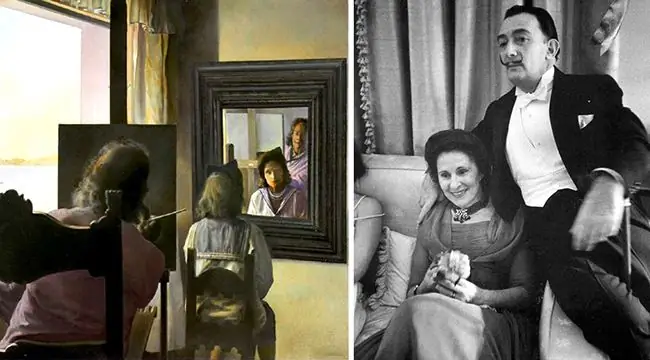
Gala managed to correctly build Dali's creative life, without prejudice to his individuality. He worked hard, sometimes 12-16 hours a day. They bought his paintings, but there was not enough money, and then Gala organized the Dali club "Zodiac", in which she managed to lure 12 of the most influential and wealthy aristocrats in France. They were not patrons of the arts. Membership in the club was paid, the fee was 2.5 thousand francs, and in return, each of them could choose, according to the month of his birth, any painting or drawing of Salvador, which was becoming more and more famous. The idea with the club bore fruit. The artist and his skin-visual muse managed to live comfortably for more than one year and, having entered the aristocratic elite of France, met the wealthy people of the American continent.
Could the humiliating fees for Dali's work and the pitiful handouts from the avaricious French aristocrats compare with the money he later received from newly minted millionaires, even without family and tribe, who forged their income from the pure American air? It is time for Gala to consider a trip to the USA.
The case ended with the surrealists, led by Andre Breton, expelled Salvador from their group. Their progressive views and ideas of communism did not allow for the possibility of personal enrichment even at the expense of their own exhausting labor, which painting was for Dali. And even more so if it was about working for the capitalists. Apparently, in their opinion, a real artist should always remain hungry, barefoot and die of cold and alcoholism somewhere in an unheated attic workshop under the roofs of Montmartre.
Galu was not at all happy with this prospect. In addition, after visiting her homeland in the late 1920s and visiting her loved ones in Soviet Russia, she realized that her way there was not allowed. She tried not to maintain relations with Russian emigrants. First, before my eyes was the example of Marina Tsvetaeva, her fellow student at the Moscow gymnasium. Gala, observing all the ordeals of the genius poetess, is faced with the uselessness of emigrant companies, in which only two topics are discussed: how good it was in Russia and how to return everything that was there. Secondly, many emigrants, often without other means of subsistence, became agents and informants of the NKVD for the sake of earning money, joining in a dangerous game of not life but death.
Gala with increased attention controls every step of El Salvador, every contact, every word he uttered, every action he took. She tries to protect her future genius from everyday life, in which he is provincial shy and inexperienced. Accustomed to sound and creative solitude rather than publicity, he knows nothing about doing business and making deals. The well-developed properties of Gala's skin vector allowed her to become one of the best impresario and organizer of all her affairs and the artist.
Dali's wife and muse are often accused of greed and avarice, but no one tries to see the huge work that Gala spent day and night, without days off and holidays throughout her life together with El Salvador. She created from an unknown Catalan who was not able to feed herself with her paintings, who in a sound way loves the abandonment of small northeastern Spanish towns, a star of surrealism.
Not understanding the true meaning of mass culture, some visual snobs call it "the spiritless entertainment of slaves after a hard day." Western mass culture is not only and not so much a narrowly focused primitive invention for empty pastime. In the developed countries of Europe and North America, it includes a large package of state social superstructures that help to level the class gap in society in the context of the globalization process. It is mass culture that allows poor and wealthy people to be in the same boat, without conflict with each other in the language of revolutions.
The family-production union of Gala and Dali, which did not fail and brought not only fame, but also huge capital, lasted more than 50 years. El Salvador, with its natural polymorphism, had to be controlled - and he himself admitted it. Hence, most likely, there was an opinion that Gala kept Dali locked up, forcing her to work hard, completely isolating herself from real life, holding all the reins of government in her own hands. To this day, she is condemned for not having enough money.
Analytical-visual critics and experts, far from the world of entrepreneurship, do not understand that Gala, with her well-developed properties of a natural skin vector, as a barometer, very accurately sensed the fluctuations of the “art market”, was able to quickly and flexibly rebuild herself and rebuild Dali, orienting him from works with “high artistic surrealistic dignity” to everyday things, not excluding work in an advertising agency. Perhaps this is where the mystery of Dali lies, whose paintings are so different and differ greatly in the periods of the artist's work.
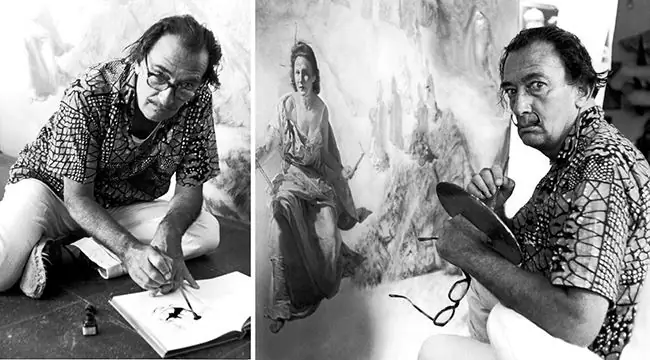
El Salvador has always been surrounded by a mass of parasites, ready to profit from him. As usual, a flock of archetypal leatherworkers appear near a big business or next to a great master, ready to snatch a bigger piece for themselves. As soon as Gala, by her age, ceased to cope with the duties of the manager of the empire, built by herself, and allowed outsiders to the aging and already sick Dali, they immediately joined their vector-specific game called “benefit-benefit”. They practically ruined the king of the surrealists, strongly discrediting the name Salvador Dali with forgeries signed by the master, forcing customers, collectors and organizers of the opening days to turn their backs on him.
Language is given in order to … be able to express misunderstanding
Dali said: “A long time ago I drew a molecule of deoxyribonucleic acid, so what? The other day, four scientists were given the Nobel Prize for having contrived to describe this very molecule. " The first part of the word "deoxyrib-" was invented by the artist, like many other things. Dropped somewhere in a conversation, at press conferences or on radio and television, they were picked up by someone and received an independent life.
Appearing in public, Dali, as if wishing to confuse his opponent, spoke in a language he had invented. People with a sound vector, if they are not satisfied with communication in the language accepted in their environment, come up with a new one. In its modern version, it is a programming language.
The artist, and in his case it was not without visual shocking, created his own - Dalian. During the conversation, even if it concerned business meetings, he pronounced one word in French, another in Spanish, the third in Portuguese, in English, in German, in Russian … Thus, the interlocutor understood only every 5-6 -th word in a sentence in accordance with the language that he himself spoke. At the same time, he was completely unable to grasp the meaning of what Dali said.
It was not Esperanto: to use what had already been invented would be too commonplace for Don Salvador. "Misunderstanding" became Dali's trump card and "the best form of communication," in his enthusiastic opinion. Urethral-sonic Dali created his own world, his empire, finding himself in it at the very top of surreal Everest. Consequently, the language in the surrealist empire must be surreal.
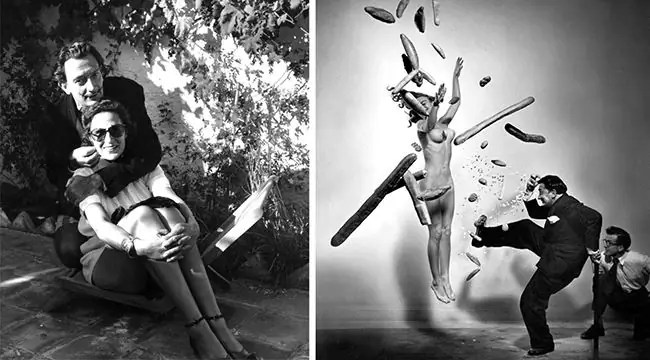
"Gala, disliked by me"
So Dali will write in one of his poems. Whatever El Salvador did, he devoted to his wife and muse Elena Dyakonova. Dalí was gushing with ideas, and while he was writing, Gala wandered around Paris trying to sell these ideas, but none of them were bought. As a novice manager who first encountered the sale of something intangible, Gala most likely did not know that such a product requires a patent.
Nevertheless, after several months, most of Dalian's ideas were implemented in design, fashion, automotive and everyday life - in a word, they were simply stolen, and someone else earned their millions by replicating them. Gala did not make such mistakes again, and the rake subsequently clearly ceased to be her instrument.
Elena Dyakonova was also feared and disliked because both of them - both the artist and the muse - led a rather secluded lifestyle, separating themselves from bohemia with its drinking binges, constant lack of money, creative envy and often suicides.
In addition, no one should have known who Salvador Dali really was. The image of a crazy scandalous artist created jointly was to the taste of Salvador, and Gala made sure that he did not go beyond his framework, and she herself not only directed, but also played along with him in everything. Gala's practicality was unique, she accurately captured everything, including the most unsightly and even of a criminal nature, but very significant events for people with a visual vector, she used them in order to promote and promote their family business.
The future empire of Dali consisted of separate fragments, which gradually grew together, leaving no hint of cracks. Gala, having survived with Dali years of lack of money, half poverty and wandering in cramped Parisian apartments and unheated shacks of Catalonia, did not want to return to the past even when they were forced to abandon all their belongings and flee to America from occupied France. Gala was not going to come to terms with the fact that Salvador was tired, tired, or he had no inspiration.
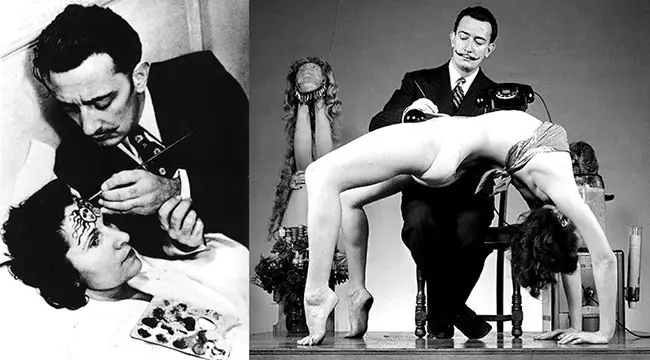
Possessing a good skin grip, Gala understands that it is impossible to find rich buyers for all of the artist's present and future works. And when the sale of paintings stalled, since not all American millionaires preferred surreal art, she invites Dali to do window dressing, develop models of accessories, jewelry and even ashtrays. Later, many of his finds, created as artistic products of decorative and applied arts with a utilitarian purpose, were put on stream and began to bring stable profits, anticipating the appearance of the offspring of mass culture - the pop art direction.
Gala was considered greedy, cruel, immoral and generally saw in her the very embodiment of evil. But it was the artist's wife who taught him how to work on good canvases, high-quality brushes and paints, use the best solvents, as well as wear expensive suits, live in the best hotels, and eat in star restaurants. It was Gala who constantly cultivated and maintained in El Salvador a sense of genius and consummation, forcing everyone else to bow down and revere the artist, the leader, the king he had dreamed of being since childhood.
And if, when he was a student at the Madrid Academy with modest means, it was difficult for young Dali to keep up with the golden youth from the best families in Spain, among whom were his friends García Lorca and Luis Bunuel, now he could not deny himself anything. His success was great, and money flowed in a green stream into the pockets of the spouses.
"They're trying to create a monster of sensations out of me, I'm not going to interfere with them … it won't hurt me …"
Incomprehensible frightening images from the subconscious, dressed in surreal forms by the skill of the visual vector of the sound engineer Dali, were liked by his buyers and customers who had the same “vision in fear” as the artist himself. The difference between them was that Salvador Dali successfully sublimated his fears into his own art, and most of the owners of his paintings and visitors to exhibitions, on the contrary, swing them to the level of grotesque, surrealistic fears, contributing to the growth of the list of phobias to more than 20 thousand varieties and without leaving psychologists and psychiatrists without work.
The impracticality and isolation from everyday reality frightened Salvador, immersed in his versatile creativity. Sometimes he didn't even know how to pay for a taxi, but the real disaster for him began when Gala, at the age of 80, wished to leave the artist and move to her own castle. Gala was tired of Dali's life: her husband, who got out of his sonic shell of solitude, royally ate in his big house with gardens and pools the joy of life in the form of noisy orgies, to which every rabble flocked.
Near Dalí's house in Port Lligat, hippie “flower children” - exhibiting skin-visual boys and girls - are located in a colorful camp. It was the peak of their youth subculture movement, which emerged in the 1960s in the United States in opposition to the Vietnam War. Hippie slogan "Make love, not war!" - "Make love Not War!" impresses the Dali couple.
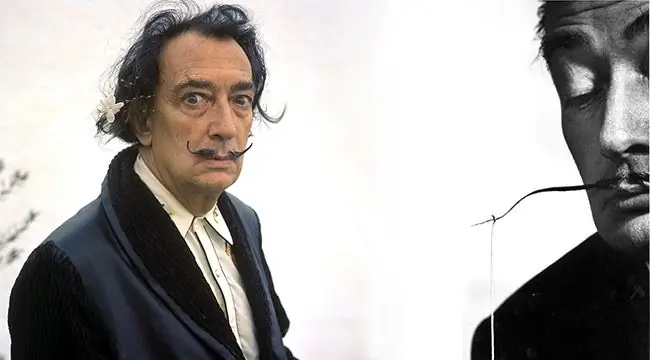
First, they have always remained apolitical, not sharing the ideas of communism and fascism confronting each other. Attempts by Andre Breton and other surrealists to "reason" Dali and instill in him communist ideals came across a blank wall erected by Gala, and the artist's act of "desecration" on his canvases of the image of the leader of the world proletariat, Vladimir Lenin. So a communist, despite the grotesque "performance" of Hitler in some works, did not work out of Dali. In fact, El Salvador was as little interested in communism as in fascism, whose support they did not tire of attributing to him. Dali is reproached for sympathizing with the Spanish dictator Franco, when the artist openly supported the shooting of a handful of separatists, explaining in an urethral way that by destroying a small group, we save the people.
Dali, himself an exhibitionist by his visual nature, willingly accepted all this naked, stoned, merry crowd of hippies who were copulating in front of his eyes. Rising above “his flock” on this “public bite”, he urethrally felt like a leader or a monarch.
Dali's last "love"
Gala achieved everything she dreamed of: fame, fame, money, satisfying all her mercantile, ambitious needs, satisfying her vanity and pride. The tasks that she set have long been completed. Gala made Dali the richest man among artists. His empire became too large, and Gala could no longer cope with its management. She, who never let go of the artist a single step, corrected every phrase she said, determined the accuracy of every deed, disposed of all his affairs, now she intended to leave the artist.
The last muse of the artist, who brightened his loneliness after the departure of Gala, was Amanda Lear - a person with a vague origin and an even more vague gender identity. It is known that Dali met her, a half-girl-half-model, in the Parisian club of transvestites on a tip from one of the guests who were present at the "royal receptions" with a hippie color in Port Lligat. Their relationship lasted more than 15 years and was more friendly than loving.
Gala, realizing that the artist needs a new muse, a new source of inspiration, “passed” Dali from hand to hand. According to their joint idea and, most likely, a previously developed script, Amanda accompanied the artist everywhere, and often the three of them appeared at receptions.
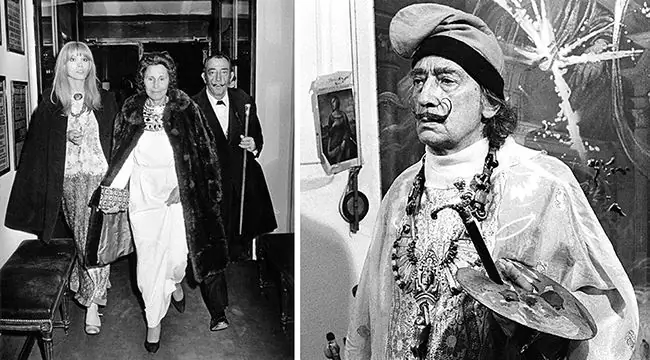
Gala and Salvador were not at all embarrassed by Amanda's “duality of nature”. People from show business, who knew Madame Lear and something from her life more than others, were intrigued by this relationship, and the audience, despite the already experienced sexual revolution, the triple alliance Amanda - Dali - Gala never ceased to shock. For Dali, with his urethral vector, there are no blinders, prejudices, restrictions and divisions on any grounds, be it men, women, homosexuals or lesbians. For the urethral leader, this is all his flock, which belongs to him.
Dali's condition is gradually deteriorating. He shows symptoms of Parkinson's disease. He very quickly turns into a helpless old man, and Gala, still active and fit, starts another romance. The skin vector requires constant renewal, and skin-visual women are able to remain youthful for a long time.
El Salvador looks at his wife's hobbies without jealousy. Now two couples appear in society. Dali with blonde Amanda and Gala with the same blonde and long-haired drug-dabbling Jeff.
Gala's new passion is the American skin-sound-visual rock singer Jeff Fenholt, known throughout America for playing the title role in the Broadway musical Jesus Christ Superstar. It is in vain that many authors endow him with the derogatory epithets "unknown" and "talentless." Mediocrities who have withstood a huge competition to get this role, and appear every evening on the stage of any theater on Broadway, and even more so who performed the main role in the most significant musical of those years by Andrew Lloyd Weber "Jesus Christ Superstar", in the skin world where everything, especially on art, money is made, no one will keep. It is quite natural that this hobby in Gala's life was short-lived and the last.
After the departure, and then the death of Gala, Dali began to use archetypal skins for their own purposes in the most insolent way. Amanda Lear recalled how the already sick master, who was unable to hold the brush, was shoved with blank sheets of paper, where he left his sweeping autograph.
Now there was no one to control Dali's behavior, restrain his urethral impulses and correct "in the afternoon the mistakes made by Salvador in the morning", as Gala did. The entire environment of the great maestro, including his publishers, who earned fantastic sums on behalf of the King of Surrealism, took part in the process of falsification, which received international publicity in the early 80s.
These "masterpieces", which have penetrated the international art market, still surface at exhibitions and auctions, striking with unnaturally primitive images that have nothing to do with Dali's brush, possessing only one value - the artist's genuine signature, have provided work to a large number of experts, journalists and other specialists.
If not for the death of Gala, which the artist put on the same rank with himself, signing the works "Gala - Salvador Dali" created by him, perhaps the terrible misfortune would have passed him. The artist, badly injured in the fire, was never able to recover after.
***
Gala and Salvador Dali are a couple in which partners helped each other to realize everything that was given to them by nature. Gala received satisfaction, filling the desires of her ambitious skin vector, and all his life El Salvador was engaged only in what he loved - painting and fooling around, fulfilling his natural destiny to become a monarch, rising above everyone.
In his will, he asked to be buried among his paintings. Even after his death, he did not want to join the sagradafamílide Dali, to his "holy Dali family", preferring to lie separately from all relatives and his twin brother. Although, if he were buried in the family crypt, the inscription would look quite in the spirit of the maestro's surrealism, something like: "Here are Salvador Dali …"
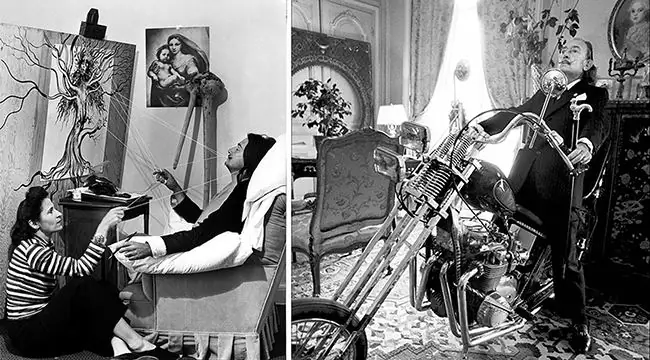
Urethral leaders, even after death, do not tolerate restrictions and family sarcophagi, preferring to remain with their people. Dali remained, as he lived, in the spotlight.
Salvador Dali, "who has long been missed by the straitjacket," according to the artist's own definition, bequeathed to bury himself in the center of the museum of his own name. His ashes are located under the most ordinary concrete slab, and few of the museum's visitors come to mind that, leaving this place, they mentally carry his ashes on their feet.
Many great urethralists, leaving life, bequeathed to scatter their ashes across the steppe or the sea, so that each of its dust particles, carried away on bare feet or on the wings of birds, would not disappear, but would sprout in the earth or turn into a myriad of stars, giving new urethralists life. and hope for everyone else.






